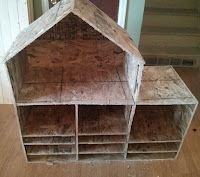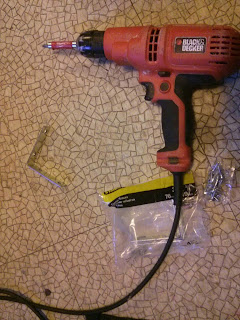How do you cover a doll house made from OSB?

When “Spiderman Jr.” selected the present he wanted to make for “Little
Fish” for Christmas I had more than one reaction; excitement, happiness,
wonderment and a lot of fear. I was glad
he wanted to make her a doll house and I loved that he wanted her to have one I
thought she couldn’t help but love.
However, I was afraid because I have never made anything like
what he wanted to make her and I knew what he wanted to make was well outside
of our budget. I couldn’t bear to tell
him no, he was so excited. So I told him
thank you for picking what you want to make your sister and sent him off to
play while my heart sank inside.
“Spiderman Jr.” and I tried to use some scrap to start building
it after we did some measurements but we didn’t have enough of the same
thickness of wood. The wood was not even close enough in thickness that I could
reasonably plane the wood to make it even.
After about two weeks I expressed my concern and frustration to my
husband. How can we make this work?
My sweet husband hopped on his computer and started looking up
types of wood. He calculated how much wood would be needed with the measurements
of the doll house and totaled up the cost.
All of the woods were outside our budget.
Then he asked if the wood needed to be pretty? I paused and thought
about it and said “No” we can paint it.
He then showed me OSB wood. Its sturdy (it's used in sub flooring in
real homes), cheap and really ugly. I recognized
this wood, I have used this type of wood before and painting it is hard because
it absorbs the paint too well. It takes a lot of paint to make it remotely look
good and can feel ruff even when painted.
I was hesitant to go with
this wood but then when my husband ran the numbers I decided it was the option
we had to take. It would allow us to buy the materials to make the doll house “Spiderman
Jr.” wanted to make for his sister and was within our budget. I figured I would just have to use a lot of
paint.
As we were building the doll house I kept thinking about how ruff
the surface was to the touch. I tried to
find out if others on-line had found good ways to cover OSB. The best I found
was someone adding a lot of texture to it before painting. I didn’t want “Spiderman
Jr.” using mud or doing texturing. He still occasionally puts things in his
mouth that he shouldn’t.
So I keep thinking about it, really worrying about it. Then an
idea was brought to my mind. Years ago I
read a number of books on “The Great Depression”. In one of those books I read
an interview where a woman talked about how she didn’t have the money for wall
paper for her home. Her solution was to make homemade glue and take newspapers and
glue them to the wall. Then she painted over the newspapers to make her wall
paper. Anytime it needed repairs she just added more newspaper on the wall and
painted over it.
I thought why not try it
on a scrap piece of OSB. I did and it worked. It took the roughness away from
the OSB and we could use one coat of paint instead of many to get the color he
wanted to use. After a bit of trial and error with how it is best applied here
is what we found worked best for us.
Step#1
Get your newspapers (not shiny if you can) glue (Mod Podge is the
glue we used), paint brushes and scissors.
Step#2
We cut the paper to fit the place where we were going to glue it.
Step#3
I had pictures on my phone of this that I can’t
find anywhere:(
We brushed the glue evenly across the paper we had cut, making sure
to brush glue on all of the paper.
Step#4
I had pictures on my phone of this that I can’t
find anywhere:(
We carefully placed the glued paper on the walls and gently
pressed and smoothed the paper onto the OSB and the wood grabbed it just fine.
Step#5
We let it dry and then painted it in one coat. When the paint was dry I ran my hand across
the painted paper and while not smooth like glass it was so much better than
OSB. “Little Fish” is not going to get splinters from these walls and if she
damages it, no big deal it’s easy to repair.
Materials Cost
Newspaper- already had 0.00
Scissors- already had 0.00
Mod Podge- already had 0.00
Paints- left over from other projects 0.00
Total Cost
0.00
We only have a couple of steps left for him to finish “Little Fishes”
present but I am so proud of how hard he has worked on her gift. Almost three
months of effort and work is a lot of work and focus for a little one.
























































